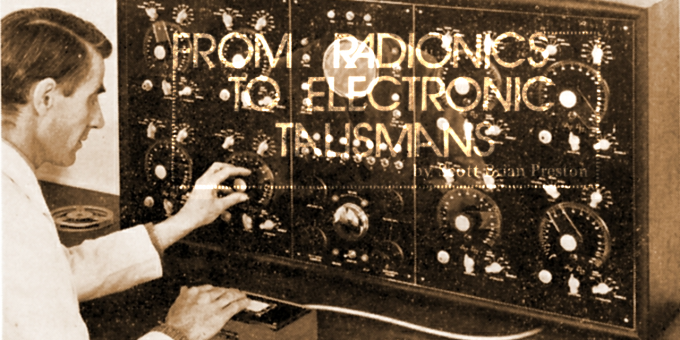
Through countless centuries magicians have used inexplicable and oddly designed talismans for everything from maintaining health to finding true love and wealth. Today, the vanguard of electronic research is studying the characteristics of a new form of energy and its behavior in different circuitries. Could both have been dealing with the same power?
This historical article by Scott Brian Preston presents one of the early attempts to relate the practice of radionics to occult magick and examine it as such. Originally published in Llewellyn’s magazine Gnostica News, No. 41, February/March 1977 (Volume 5 Issue 5).
I
The Little “Black Box”
A man walked into Mankind Research Unlimited (MRU) in Washington, D.C. with two small boxes. They were smaller than cassette tape recorders; they had meters, a series of dials, input and output jacks and telescoping antennae. To me they appeared to be homemade voltmeters, but I was wrong. It was as though a man from a distant galaxy had landed with boxes from a hardware store of the future and decided to let me in on a wild little secret.
The boxes were for agricultural pest control and had just been used in a successful demonstration for some ranchers in Texas. The boxes were supposed to amplify and broadcast frequencies that are detrimental to the health of insects.
The man was Mr. Edward Gross and the boxes were the culmination of years of research by people with top credentials in electronics, medicine and biochemistry. Mr. Gross casually explained that if the juice of a plant is mixed with insecticide, placed on a copper plate and fed through the circuitry of the little black box, then the insects on the plant will die as if they had been sprayed with the poison.
It was an amazing idea, but what came next was even more astounding: the notion that when a photograph of a farmer’s field is smeared with insecticide and placed on the copper plate, the insects in the field will react as though they have been sprayed with poison. If a corner of the photograph is cut off, the corresponding portion of the field remains untreated: often the insects from the treated portion will crowd into this untreated section.
What seems like a new form of voodoo — this killing of bugs with a picture — is part of the science of radionics.
II
Early Development
The term radionics was probably coined by Dr. Albert Abrams in the early 1920‘s; the word was derived from radiation. Dr. Abrams, a highly talented and well-respected physician, believed that all substances emit specific vibrations which are characteristic of their molecular structure. Disease, he said, was simply a change in the electronic frequency of the body — such changes could be measured.
Albert Abrams, M.D. was born in San Francisco in 1863. He studied medicine in Heidelburg, Germany, where he graduated with the highest possible honors. During his career he became well known throughout the medical world for his discovery of cardiac and pulmonary reflexes, which was an important advance in medicine. Sir James Barr, past president of the British Medical Association, said that Abrams was the greatest genius that the medical world had seen in 50 years. “In America and France,” said Sir James, “Abrams’ cardiac reflexes must have saved thousands of lives.”
In the early days of modern medicine, doctors relied heavily on percussion in diagnosis — the idea that an ailing lung or cancerous abdomen has a different resonance from a healthy organ, just as a drum’s resonance differs if it is stuffed with rags. Dr. Abrams was one of the best at percussive diagnosis; he was an accomplished musician and had perfect pitch.
In the early 1900’s Abrams was examining a patient with a small epithelioma, or cancer, of the lip. He checked the abdomen to make sure there were no tumors. An area of several square inches over the patient’s navel yielded a dull, spongy note instead of the expected hollow sound.
Worried that there might be a growth, he had the patient lie on the examining table. However, on the table, the patient’s abdomen showed no palpable growth and resounded with a normal hollow sound. When he made the patient stand in the previous spot, the dull sound returned.
After moving the patient around for several hours, Dr. Abrams found that the dull sound only occurred when the patient faced west. A normal, healthy subject conversely showed a clear resonance at all points of the compass. Abrams concluded that the change in pitch was due to the electronic influences of the disease.
In 1916 he published a sensational book called New Concepts in Diagnosis and Treatment, in which he maintained that disease is an electronic disharmony in the body. If the changes he was dealing with were electrical, then it should have been possible for them to conduct the alleged disease frequency down a wire.
A long electrical cable was mounted with aluminum disks at both ends. One disk was connected to the forehead of a healthy subject; the other end of the cable was concealed behind a curtain where an assistant randomly touched the electrode to an excised cancer. The subject was asked to face west. When the electrode was touching the cancer, the healthy subject would develop a dull resonance just over the navel; when the electrode was taken away, the subject exhibited the normal hollow resonance. Every effort was made to determine the validity of the phenomenon. Abrams found that he could invariably determine when the subject was connected to the cancer.
For a number of years Abrams tested diseased patients in hospitals and clinics throughout San Francisco. He believed that the subtle ernanations from diseased tissues cause neuro-muscular reflexes in the human body that can be detected. For a long time these reactions became known as the “Electronic Reactions of Abrams” or “ERA.” Extensive testing showed that the reactions could be quite varied.
Different diseases cause changing resonances in different parts of the body. Tuberculosis creates a dull reflex just under the navel; a streptococcus infection causes a dull resonance on the immediate left-hand side of the navel; malaria has a similar effect on the left lumbar region. Abrams could distinguish over half a dozen diseases with percussion alone, but an exact diagnosis of each disease is more complicated.
Syphilis gave the same reading as cancer. Other diseases shared symptoms and a method had to be devised to distinguish them. The simplest means was to measure the variable resistance.
Using three variable resistors in series, he was able to measure approximately the resistance in ohms. He connected the resistor box between the cancer specimen and the subject to be percussed. No reaction was noticed until he lowered the resistance to approximately 50 ohms; then a dull note was heard. It was found that syphilis would only produce a dull resonance at 55 ohms. The difference between sarcoma and cancer could even be detected, since sarcoma would only produce a change of pitch at 58 ohms.
Abrams also found that a blood sample could be used for an effective diagnosis and that it could be used indefinitely — it appeared to change its characteristics to coincide with the health of its donor.
After thousands of experiments and years of research, Abrams compiled an atlas in which he recorded and cross-referenced all the major diseases according to their resistance values. Using this record and his simple apparatus, he was able to diagnose all major diseases with nearly 100 per cent accuracy. Even though he was able to duplicate his experiments before numerous observers, there were those who refused to accept the premise behind the phenomenon. The idea that disease could be caused and treated by altering electronic frequencies presents too radical a view of the world for most health professionals, even today.
During a demonstration a skeptical doctor, who had been suffering from a mild undiagnosed chest pain, offered a sample of his blood to Abrams. Abrams confounded and embarrassed the physician by telling him that he had syphilis. The physician furiously denounced the diagnosis as “bunk!” “I don’t care what your reactions say; I never had it!”
Dr. Abrams responded with an equal fury: “My work is bunk, is it? I’ll tell you if you caught it from a male or female and the site of inoculation!”
Abrams derived from the location of the dull spot that the skeptical physician had contracted the disease from a male. Sweeping an electrode over the physician’s body, he determined that the site of inoculation was the middle finger of the left hand. The finger revealed a small scar. The former skeptic admitted that he had punctured the finger while performing surgery on a male patient; it took a long time to heal, but he never thought it was a chancre. Subsequent tests revealed that Abrams had been correct.



